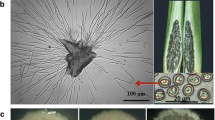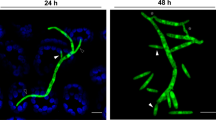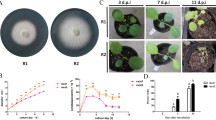Abstract
Ustilago esculenta is a fungal endophyte of Zizania latifolia that plays an important agricultural role in this vegetable crop. The purpose of this study was to characterize sporidial (T) and mycelial (M-T) strains of U. esculenta isolated from sporulating and non-sporulating galls on plants growing in Zhejiang province, China. Morphological comparisons of the T strain and M-T strain were made by optical and scanning electron microscope observation. Genetic differences were examined by sequencing the ITS region of the fungus and examining differential protein expression by two-dimensional gel electrophoresis and MALDI-TOF-MS/MS. The sporidial (T) and mycelial (M-T) strains differed in morphological characteristics of their in vitro single colony formations and in cell shape. Alignment of ITS sequences of the T strain and M-T strain revealed a single mutation between the T strain and M-T strain, but the sequences were the same within strains. A total of 146 proteins were only expressed in the M-T strain, and 242 proteins were only expressed in the T strain isolated from infected plants. A total of 222 proteins were up-regulated or down-regulated in the T strain when compared with the M-T strain. Of these, 18 proteins were identified and eight were associated with processes involving energy metabolism and the cytoskeleton. Two morphology-related proteins, MAP kinase kinase and actin, were differentially expressed. The differences noted in the T strain and M-T strain may lead to a better understanding of the life cycle and morphogenesis in U. esculenta.









Similar content being viewed by others
References
Camus A (1950) Les especes utiles du genre Zizania (Graminees). Rev Int Bot Appl Agric Trop 30:50–60
Chan YS, Thrower LB (1980) The host parasite relationship between Zizania caduciflora Turcz. and Ustilago esculenta P. Henn., II. Ustilago esculenta in culture. Phytol New 85:209–216
Chan YS, Thrower LB (1980) The host-parasite relationship between Zizania caduciflora Trucz. and Ustilago esculenta P. Heen. III. Carbohydrate metabolism of U. esculenta and the host–parasite combination. Phytol New 85:217–224
Chung KR, Tzeng DD (2004) Nutritional requirements of the edible gall-producing fungus Ustilago esculenta. J Biol Sci 4(2):246–252
Chung KR, Tzeng DD (2004) Biosynthesis of indole-3-acetic acid by the gall-inducing fungus Ustilago esculenta. J Biol Sci 4(6):744–750
Fan NK, Shao MJ, Li XS et al (2006) Construction and characterization of a transformation-competent artificial chromosome (TAC) library of Zizania latifolia (Griseb.). Plant Mol Biol Rep 24:219–227
Fujii Y, Konno K, Atarashi K et al (2007) A case of hypersensitivity pneumonitis caused by smut spores of Ustilago esculenta. J Jpn Respir Soci 45(4):344–348
Guo HB, Li SM, Peng J, Ke WD (2007) Zizania latifolia Turcz. cultivated in China. Genet Resour Crop Evol 54:1211–1217
Hennings P (1895) Neue und interessante Pilze aus Königl. botan. Museum in Berlin III. Hedwigia 34:10
Hung SF, Chang TL, Chen IZ et al (2006) Anatomic observation of the symbiotic coba (Zizania latifolia Turcz.) and Ustilago esculenta P. Henn. J Taiwan Soc Hort Sci 52(3):291–296
Jiang JZ, Cao BS, Huang GF et al (2005) Changes of NSC, enzymes and endogenous hormones during Zizania gall’s swelling. Acta Hort Sinica 32(1):134–137
Jiang JZ, Zhang Q, Cao BS, Zhu QS (2004) Primary study on changes of protective enzymes’ activities in Zizania gall’s swelling. J Yangzhou Univ (Agric & Life Sci Edn) 25(2):68–71
Jiang JZ, Qiu JJ, Han XQ et al (2004) Changes of endogenous hormone contents of different parts during development of water bamboo (Zizania latifolia). J Wuhan Bot Res 22(3):245–250
José RH, Alfredo D et al (1998) The fungus Ustilago maydis, from the aztec cuisine to the research laboratory. Int Microbiol 1:149–158
José RH, Claudia GL, Lorenzo GO, Alfonso CTY (1995) Yeast-mycelial dimorphism of haploid and diploid strains of Ustilago maydis. Microbiol 141:695–703
Lázaro-Diéguez F, Egea G (2007) Comparative study of the impact of the actin cytoskeleton on cell shape and membrane surface in mammalian cells in response to actin toxins. In: Méndez-Vilas A, Díaz J (eds) Modern research and educational topics in microscopy, vol I. FORMATEX, Spain, pp 362–369
Lee DB, Lee KB, Kim CH et al (2004) Environmental assessment of water, sediment and plants in the Mankyeong River, ROK. Environ Geochem Health 26:135–145
Peng XX, Ye XT, Wang SY (2004) Identification of novel immunogenic proteins of Shigella flexneri 2a by proteomic methodologies. Vaccine 22:2750–2756
Stapf O (1909) The manchurian water–rice. Kew Bu 1908:385–390
Su HJ (1961) Some cultural studies on Ustilago esculenta. Special Publication. Agric Nat Taiwan Univ 10:139–160
Terrell EE, Batra LR (1982) Zizania latifolia and Ustilago esculenta, a grass-fungus association. Econ Bot 36(3):274–285
Xu XW, Ke WD, Yu XP et al (2008) A preliminary study on population genetic structure and phylogeography of the wild and cultivated Zizania latifolia (Poaceae) based on Adh1a sequences. Theor Appl Genet 116:835–843
Yang HC, Leu LS (1978) Formation and histopathology of galls Induced by Ustilago esculenta in Zizania latifolia. Phytopathology 68:1572–1576
Yoshida K, Suga M, Yamasaki H et al (1996) Hypersensitivity pneumonitis induced by a smut fungus Ustilago esculenta. Thorax 51:650–657
Acknowledgments
This study was supported in part by “National Natural Science Foundation of China (30940018)”, Zhejiang Province Important Science and Technology Tackled Project (2004C22003), and Natural Science Foundation of Zhejiang Province, China (Y3090173).
Author information
Authors and Affiliations
Corresponding author
Additional information
Wenyu You and Qian Liu are co-first authors.
Rights and permissions
About this article
Cite this article
You, W., Liu, Q., Zou, K. et al. Morphological and Molecular Differences in Two Strains of Ustilago esculenta . Curr Microbiol 62, 44–54 (2011). https://doi.org/10.1007/s00284-010-9673-7
Received:
Accepted:
Published:
Issue Date:
DOI: https://doi.org/10.1007/s00284-010-9673-7




